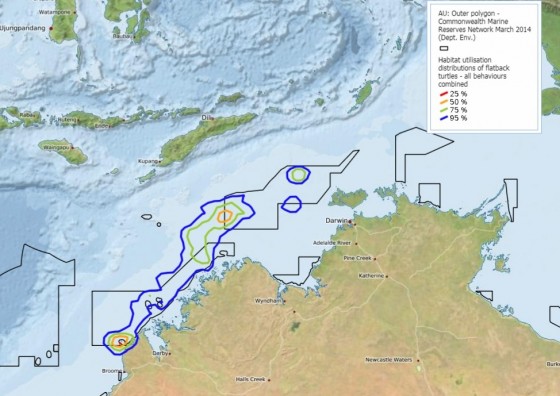Where
Lacepede Islands and the Kimberley Marine Park.
Who
Michele Thums, David Waayers, Zhi Huang, Chari Pattiaratchi, Jeffery Bernus, Mark Meekan.
When
2009
Why
Flatback turtles (Natador depressus) are endemic to northern Australia, where they nest and forage in the region's sub-tropical and tropical waters. Although it is known that these turtles migrate between foraging and nesting grounds, little is known about the post-nesting migration, the cues they use to direct these migrations and the habitats that define foraging areas. This information is important to aid in the conservation and management of this data-deficient species, listed as vulnerable under state (Biodiversity Conservation Act 2016) and Commonwealth (EPBC Act 1999) laws, particularly because this region has become a concentrated hub of industrial development with offshore gas fields and coastal processing and ship loading facilities for iron ore, petroleum and natural gas.
How
Satellite trackers were attached to the backs of 11 flatback turtles from the Lacepede Islands, and used to track their individual movements for up to 830 days from the islands, in the Kimberley Marine Park and surrounding coastline. Statistical modelling techniques were used to identify foraging grounds and migratory pathways from these tracks, as well as determine key environmental variables and habitat types that influenced the movement patterns of these animals after leaving their nesting sites.
What did we learn?
The satellite trackers showed that the turtles migrate along the coast in depths of around 63 metres to foraging grounds on the mid-Sahul Shelf in the Timor Sea, approximately 135 kilometres from land where waters are around 74 metres deep. Modelling revealed that these turtles prefer clear waters from 60–90 metres deep for foraging, and also that they are more likely to forage in areas where there is complex benthic geomorphology with seafloor features such as banks, terraces, deep holes and valleys. These areas typically support a rich diversity of sessile invertebrates, which are thought to be an important part of the flatback diet. The models also found that the distance to the tidal front was an important predictor of the turtle’s migratory behaviour, suggesting that they might follow these fronts along the coast.
What next?
Information about critical foraging habitats and migration cues is useful in spatial planning for conservation and management. This research has shown that while nesting and migration areas for these turtles are largely protected within the Kimberley Marine Park, only 50 percent of the extensive core foraging area is encompassed. Because the core foraging area is so large, protecting any more may negatively impact other users of the marine region, however with this new information, alternative and appropriate management pathways can be investigated, such as changing vessel routes and speeds.
Related data and publications
Thums, M., Waayers, D., Huang, Z., Pattiaratchi, C., Bernus, J. and Meekan, M. (2017) Environmental predictors of foraging and transit behaviour in flatback turtles Natator depressus. Endangered Species Research 32, 333-349.
Habitat utilisation distributions (shapefile) for nesting, foraging, migration and all behaviours combined.
For more information please contact marinescience@environment.gov.au.



